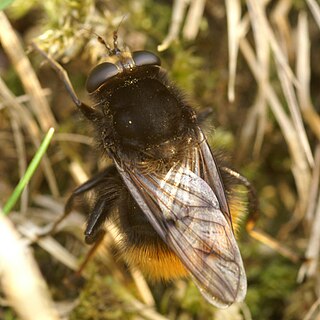Top Qs
Timeline
Chat
Perspective
Criorhina ranunculi
Species of fly From Wikipedia, the free encyclopedia
Remove ads
Criorhina ranunculi, is a species of hoverfly found in the spring in many parts of Britain and Europe.[5]
The larvae of C. ranunculi are associated with rotting deciduous wood.[a] Adults are remarkable bumblebee mimics and are usually found in woodland in springtime visiting flowers such as sallow to feed.[6][7]
Remove ads
Description
For terms see Morphology of Diptera
Large (wing length 11·25–14 mm.) bumblebee mimic. Thorax and abdomen with long, dense hairs. Hairs black on thorax and basal part of abdomen red or yellowish on tip of abdomen. Scutellar hairs may be pale yellow or brownish. Hind femora considerably thickened, especially in males. Hind tibiae sickle-shaped.[8][9][10][11]
Distribution
It has a Palaearctic distribution, including southern Norway and Sweden south to central Spain, and from Ireland eastwards through central Europe into European parts of Russia.[12][13]

Biology
Habitat includes: Betula, Fagus, and Quercus forest.[14] Adults are primarily arboreal, but descend to visit flowering shrubs in sun-lit glades. These flies are extremely fast, with a high-pitched whine, zig-zagging between the branches of flowering trees. Flowers visited include Cardamine pratensis, Cornus sanguinea, Crataegus, Photinia, Prunus cerasus, Prunus spinosa, Rubus, Salix, and Sorbus aucuparia.[15] The flight period is from the beginning of March to mid May (later at higher altitudes).
See also
Other bumblebee mimics are Mallota, Arctophila, Merodon, Pocota and Brachypalpus. Criorhina differ from these genera in the form of the antennae.
Notes
- Despite the specific name, the species has no special association with Ranunculus buttercups.
References
External links
Wikiwand - on
Seamless Wikipedia browsing. On steroids.
Remove ads

